Asus ProArt Studiobook 16 OLED (H7604) 2023 review: Display
In terms of color accuracy and coverage, Asus throws everything it can at the screens in its ProArt range. Here, that includes Calman Verified and Pantone Validated certifications, with the guarantee that each panel’s average Delta E (a measure of color accuracy) will be under two. Our panel’s accuracy was even better: it averaged 0.51 and had a maximum Delta E of 1.12.
Color coverage is superb, too. You have a choice of color profiles, including DCI-P3, where it covered 99% of the gamut. Print designers who prefer to work in the Adobe RGB space should stick to the Native profile, with 98% coverage.
But what really matters about this OLED panel is that it’s gorgeous. You benefit from incredible sharpness thanks to a resolution of 3,200 x 2,000, and whether you’re watching a film or editing photos you’ll fall in love with the rich colours and deep blacks. While a peak brightness of 363cd/m2 may not sound noteworthy, support for DisplayHDR’s True Black 500 shows that it can go higher in localized areas in supported content.
Its results in our 1080p gaming benchmark suite were predictably high: 186fps in F1 22, 144fps in Shadow of the Tomb Raider, 101fps in Metro Exodus, and 88fps in Metro Exodus Enhanced Edition. Those are all at High settings. Switching to the native resolution of 3,200 x 2,000 saw those figures drop to 105fps, 94fps, 56fps, and 45fps.
All our results were with the Studio drivers and the laptop in «MSHybrid» mode, where it automatically switches between discrete and integrated graphics. You can choose to use only the discrete GPU, but that made no difference to our results so we suggest sticking with the default.
Not least because using integrated graphics will squeeze some extra life from the 90W battery. The Studiobook is a power-hungry beast, and the best result we saw was in PCMark’s idle test where it kept going for 6hrs 36mins. It lasted around five hours in both the video-rundown and light-use office tests while switching to gaming reduced life to a mere 1hr 34mins. Those results are typical of a Windows workstation such as this, but the 16in MacBook Pro lasted for almost 20 hours in our video-rundown test.
Зайду с козырей. У этого лэптопа фантастический дисплей
Свежая новинка от ASUS получила 16-дюймовый OLED-экран с разрешением 3840х2160 (да-да, честные 4K). Соотношение сторон стандартное: 16:10.
Максимальная яркость — 550 нит. И ее вполне хватает для комфортной работы в любой точке планеты. Буквально сегодня писал часть этого обзора с этого ноутбука, ничего не бликало и не заслонялось солнечным светом.
Более того, здесь есть поддержка HDR10 и 100-процентный цветовой охват DCI-P3. Экран передаёт настолько сочные цвета, насколько это вообще возможно.
Это отличное решение для работы с графикой и изображениями. Цветоотображение такое же, каким я вижу все в реальной жизни. Дизайнеры точно оценят.
Каждый экран калибруют на заводе, чтобы пройти сертификации PANTONE Validated, Calman Verified и VESA DisplayHDR 500 True Black и обеспечить комфортное пользование. Это гарант качества.
Наверное, настолько четкого, яркого и насыщенного дисплея я не видел ещё ни на одном ноутбуке. Про MacBook вообще молчу, ему до такого ещё идти и идти.
Углы обзора широкие, всё видно даже в случае, если смотреть на экран почти сбоку. Очень порадовало отсутсвие ШИМ (ну или я его не заметил), чем любят грешить OLED-дисплеи при пониженной яркости.
Рамки тонкие, почти незаметные. А в верхней спряталась фронтальная камера с ИК-датчиком, что видеть пользователя в темноте. Полезная штука, ещё и разблокировку через Windows Hello поддерживает.
Дисплей
Из-за солидного веса крышка уверенно открывается одной рукой. Внутри располагается 16″ OLED-матрица 16:10 с разрешением 3840 × 2400 точек и частотой обновления 60 Гц. Производитель заявляет о 100% охвате цветового пространства DCI-P3, яркости до 550 кд/м² шустром отклике в 0.2 мс и наличии сертификатов Display HDR True Black 500, Pantone Validated и SGS.
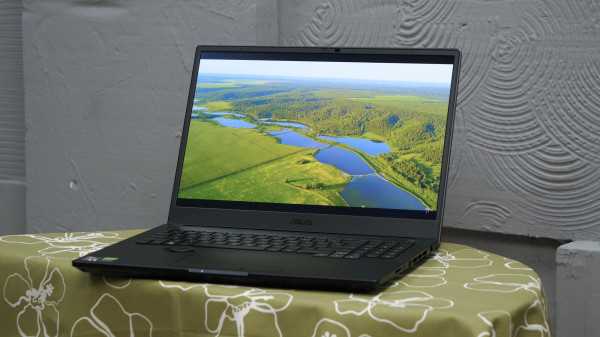
Дисплей уже из коробки радует отличными цветами, но в фирменном софте предусмотрен отдельный пункт для калибровки (требуется внешний калибратор). Горизонтальный угол обзора отличный, запас яркости внушительный (правда, HDR-режим не доступен в автономном режиме), а соотношение сторон чуть вытянуто вверх (относительно 16:9), что полезно в рабочих задачах.
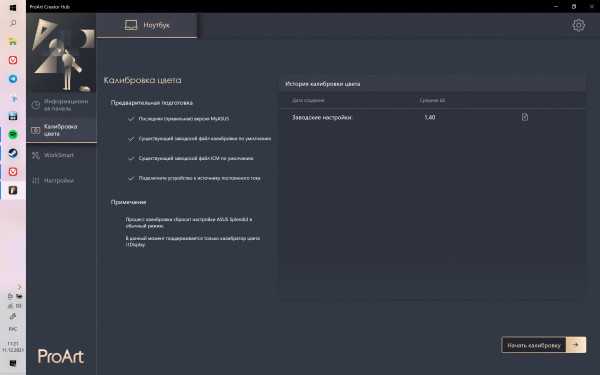
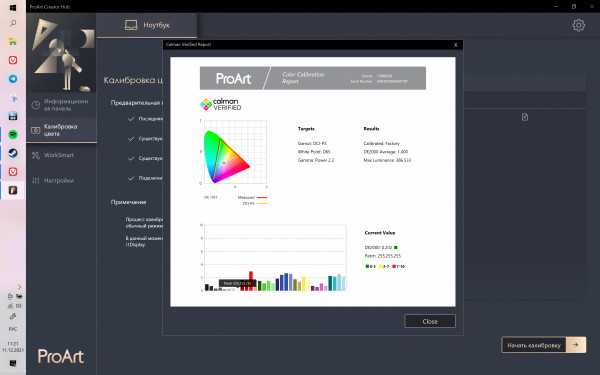
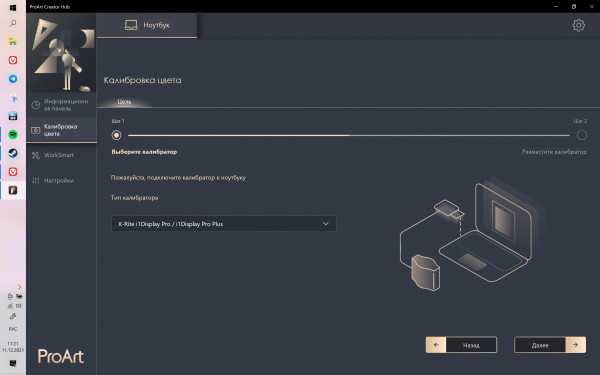 Настройки калибровки в ProArt Creator Hub
Настройки калибровки в ProArt Creator Hub
Наконец, нельзя не остановиться на главной особенности – матрице типа OLED. С одной стороны, она приносит с собой красочную картинку и настоящий чёрный цвет, смотреть на которые одно удовольствие. С другой, может напрягать глаза и требует особого отношения из-за не иллюзорной опасности выгорания (появления «отпечатков» от изображений).
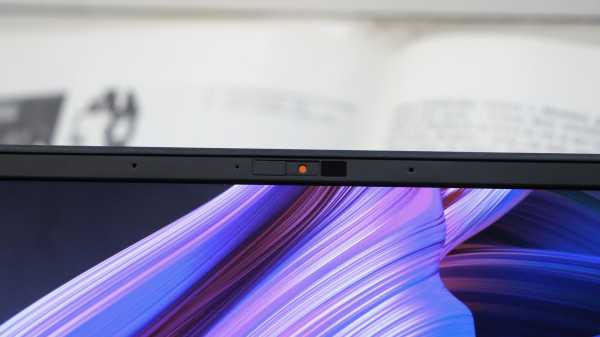
Для продления срока службы дисплея ASUS предлагает ряд мер, объединённых в группу ASUS OLED Care, а также не рекомендует выводить на дисплей статические изображения на высокой яркости на длительное время. Учитывая, что мы говорим об ProArt Studiobook 16 OLED – устройстве для работы (как правило, в одних и тех же программах на протяжении длительного времени), это может оказаться проблемой. Хотя от местной максимальной яркости глаза вытекут куда раньше появления любых «отпечатков».
 ASUS OLED Care поможет сохранить матрицу
ASUS OLED Care поможет сохранить матрицу
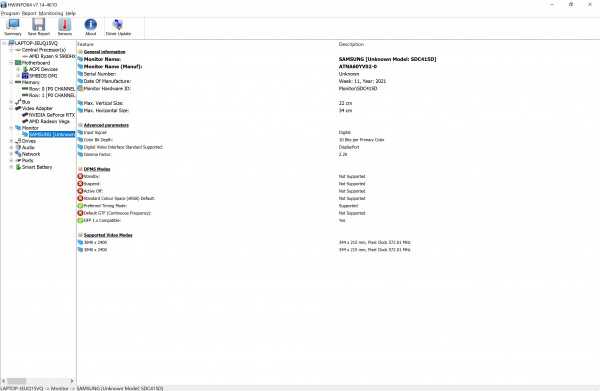

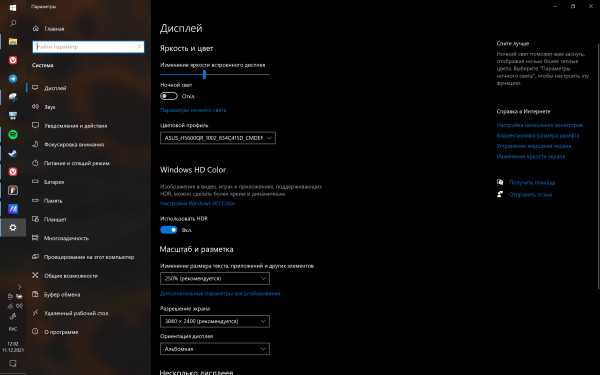 Информация о дисплее
Информация о дисплее
В рамке над дисплеем нашли своё место массив микрофонов и Web-камера с поддержкой Windows Hello. Последняя может быть как закрыта физической шторкой, так и отключена функциональной кнопкой. Максимальное качество видеосъёмки 720p@30fps, фотосъёмки – 1280 на 720 точек. Качество фотографий и видео среднее, а вот звук пишется хорошо.
 Web-камера
Web-камера
Design and Connectivity
As equipment aimed at professional or semi-professional users, the ASUS ProArt Studiobook Pro 16 OLED W7604 It moves away from the most striking designs of the company’s gaming line, and opts for a much more sober finish, with a smooth lid on the top, joined by two hinges that are located somewhat forward with respect to the rear edge. It can be read in the ProArt center in chrome letters.
Its design offers a maximum thickness of 2.39 cm in its thickest part, a measurement that is reduced in the thinnest areas to just over 2 cm. It’s not an ultrabook, but considering its internal hardware and features, it’s pretty slim.
On the right side we have, from left to right, two USB-C ports with Thunderbolt 4.0 connectivity followed by a 10Gbps USB-A 3.1 port (now known as USB 3.2 Gen 2). To the far right, an air outlet from the right heatsink ends up closing the side.
On the left side, in addition to another air outlet, we have another 10 Gbps USB-A 3.1, a combined 3.5 mm audio port and an SD Express card reader capable of reaching 985 MB/s, ideal for users who transfer long files from video or photography cameras using this type of media.
The rest of the physical connectivity of the laptop is found on the back, with an HDMI 2.1 port in the central area, followed by the power connector for the 240 W source. On the right side we have an RJ-45 port with Ethernet connectivity 2.5 Gbps. Additionally, two air outlets join the other two on the sides for the equipment’s cooling system.
Opening the screen we find a 16:10 and 16-inch OLED panel, as it is touch-sensitive we have a glossy coating, which although it is not one of the most reflective on the market, the reflections of what we have can be seen without problem back. It is integrated into fairly contained frames, even at the bottom thanks to the use of the 16:10 format.
The complete keyboard uses membrane mechanisms, with a more than correct path and good rigidity in the structure, the numerical area on the right side is appreciated, and the placement of the direction arrows is striking to take advantage of the space. It has white LED backlighting. However, in this area there are two elements that take away its prominence.
One is the trackpad, which instead of having a system of physical buttons, includes haptic feedback through vibration, making the entire trackpad also a button and recognizing presses from the right or left.
Another is the ASUS Dial that we already saw in other models such as the StudioBook 16 OLED based on the Ryzen 5900X, it is a configurable wheel with a button that is automatically associated with different functions depending on the program used.
It can work as standard as if it were a Microsoft Wheel like those in the Surface range, or it can also be customized or apply ASUS settings for applications such as Office, the Adobe Suite, browsers, Spotify, etc.
Depending on the program, we will have different functions, and we can add or edit the ones we want. The ASUS software will recognize each program and activate the specific functions of the Dial.
Performance
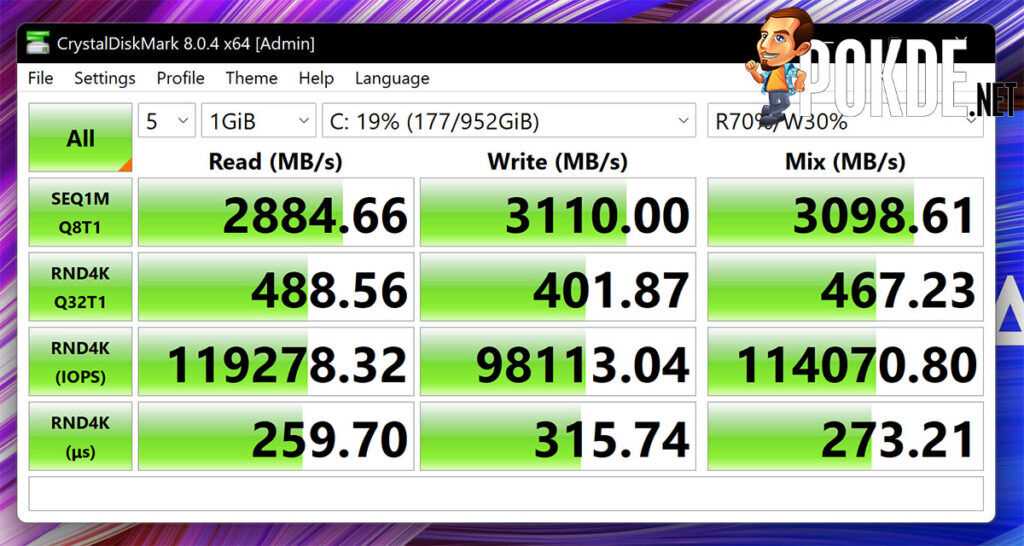
The WD PC SN730 SSD here is quite fast, with close to 3000MB/s read and write speeds. You can also drop in another SSD, as the ASUS ProArt Studiobook 16 OLED (H5600) does have a secondary M.2 slot if you decide you need more storage space.
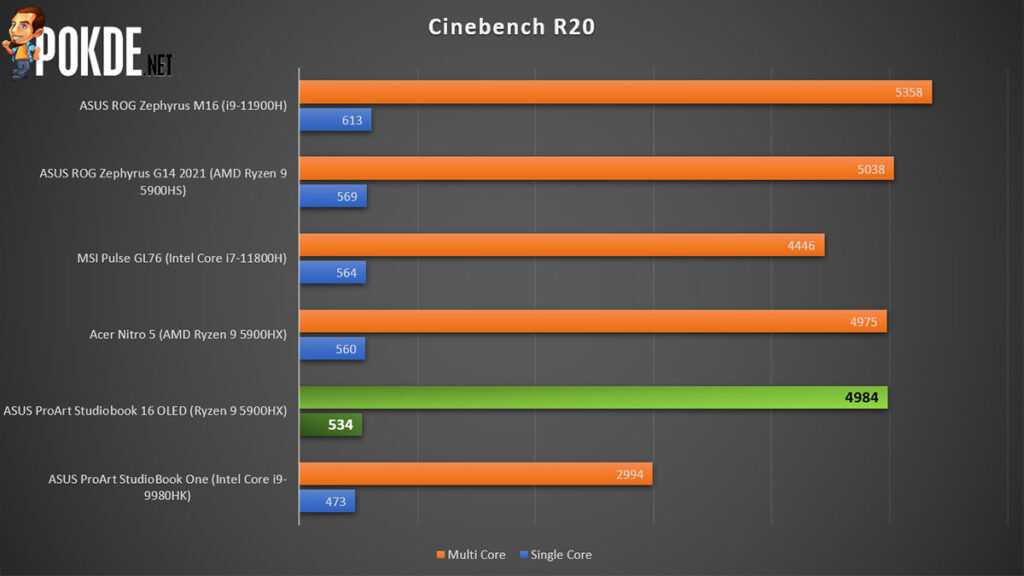
When it comes to CPU performance, the ASUS ProArt Studiobook 16 OLED (H5600) posts slightly slower scores than most of the other laptop in these charts. It does quite easily outperform the last-gen ProArt Studiobook One, although it is worth mentioning that the ProArt Studiobook One was already outdated back when it was launched.
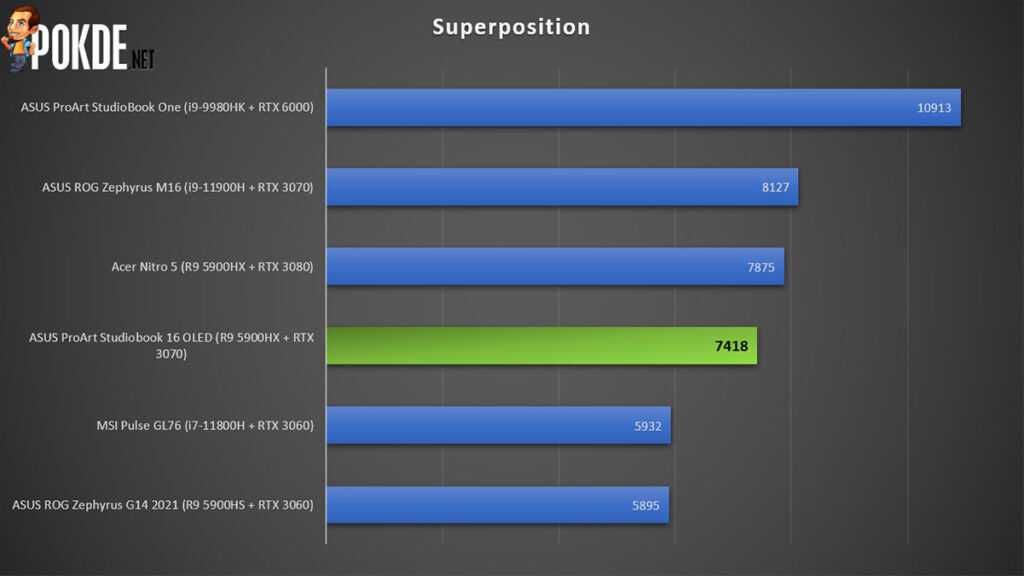
In Superposition, the ASUS ProArt Studiobook 16 OLED’s GeForce RTX 3070 scores more than the GeForce RTX 3060 laptops, but it is slower than the GeForce RTX 3070 in the ROG Zephyrus M16. The tables turn here for the ProArt Studiobook One, as the ASUS ProArt Studiobook 16 OLED is a good 33% slower, which is to be expected since the RTX 6000 is actually faster than the desktop GeForce RTX 2080…
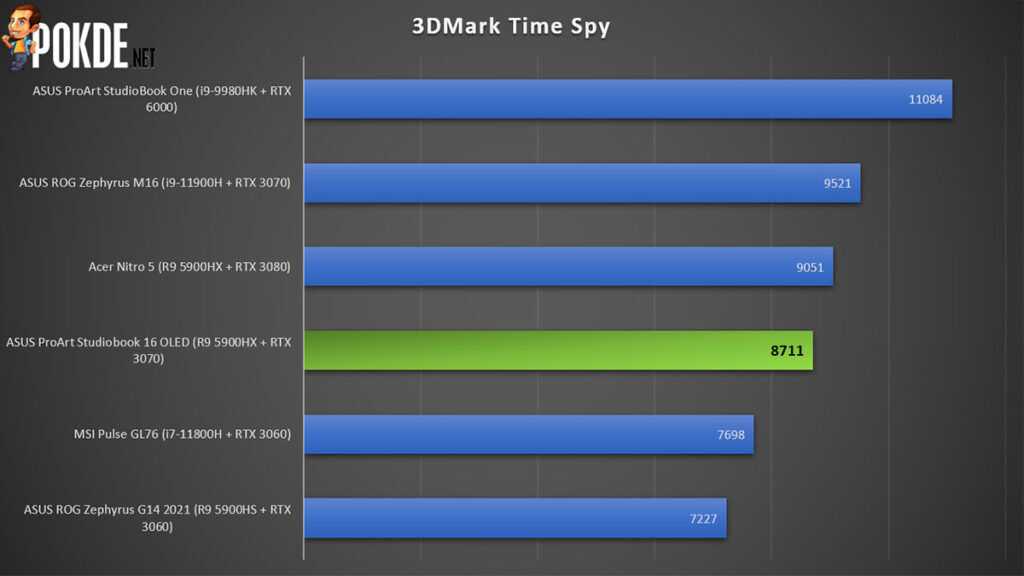
In 3DMark Time Spy, the ASUS ProArt Studiobook 16 OLED sits in the same position the stack, being faster than the GeForce RTX 3060 and slightly slower than the GeForce RTX 3080. The ASUS ProArt Studiobook 16 OLED (H5600) is 22% slower than the ProArt Studiobook One here.
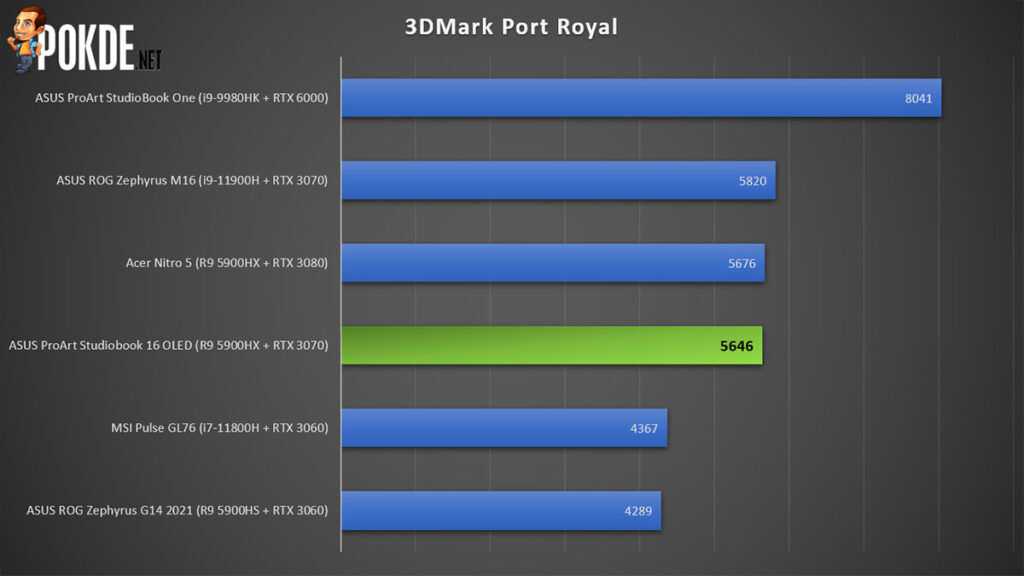
The gap between the ASUS ProArt Studiobook 16 OLED’s GeForce RTX 3070 and the Acer Nitro 5’s RTX 3080 is even narrower here. This is a gauge of raytracing performance in games, and we can see that the ASUS ProArt Studiobook 16 OLED (H5600) is a pretty great performer here. Overall, gaming performance should be great, which should come as no surprise for a laptop with a GeForce RTX 3070 under the hood, but this is a content creator laptop, so let’s see how it does in PCMark.
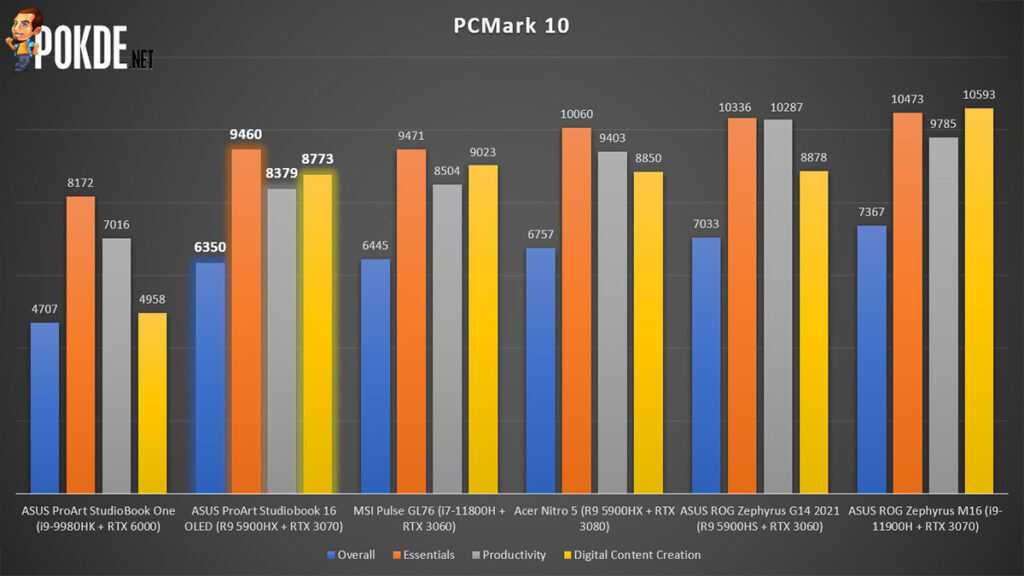
The ASUS ProArt Studiobook 16 OLED’s content creation capabilities definitely outclasses the ProArt Studiobook One, presumably because of its faster CPU. As a whole, it is not the fastest laptop we have tested, with most of the other laptops in this collection outperforming it.
Battery Life
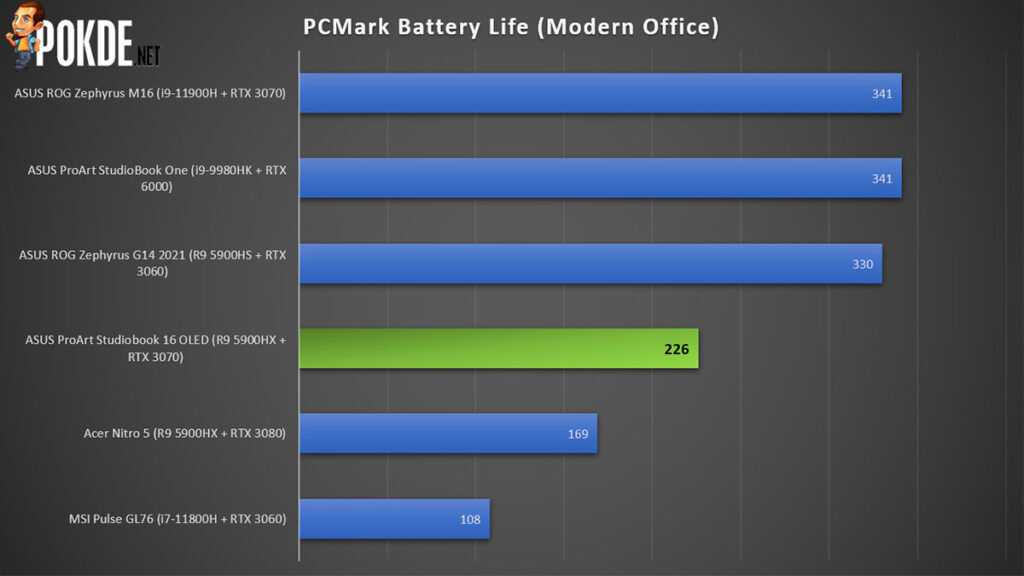
Battery life is quite lackluster here, as ASUS seems to have forgotten to add an iGPU mode here to improve battery life by switching off the dedicated graphics, something which is included with ASUS’ gaming laptops. Less than four hours of battery life is definitely not that great when you are out and about, but I guess most users of this sort of machine won’t be relying on the battery much, as you can’t get the most performance out of it on battery anyway.
Thermals
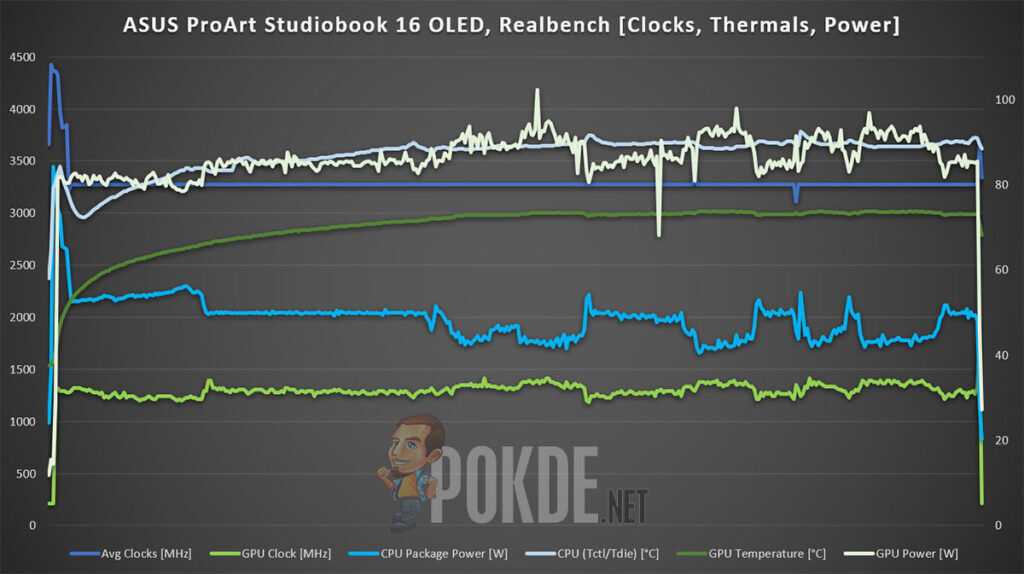
The ASUS ProArt Studiobook 16 OLED’s cooling does a pretty good job of maintaining thermals where they should be. While the CPU pulls up to 84.31W, the highest temperature recorded was only 92.4°C, with the average being just 87°C. On average, CPU clocks hovered at 3.29GHz while pulling 48.63W, with peaks of 4.37GHz. Meanwhile the GPU clocks are hovering at 1298MHz with a power draw of 86.2W on average, while temperatures were below 73.8°C at all times. No throttling to be observed, and it seems that ASUS decided to optimize for lower thermals over flat out performance, as evident in the benchmark scores above.
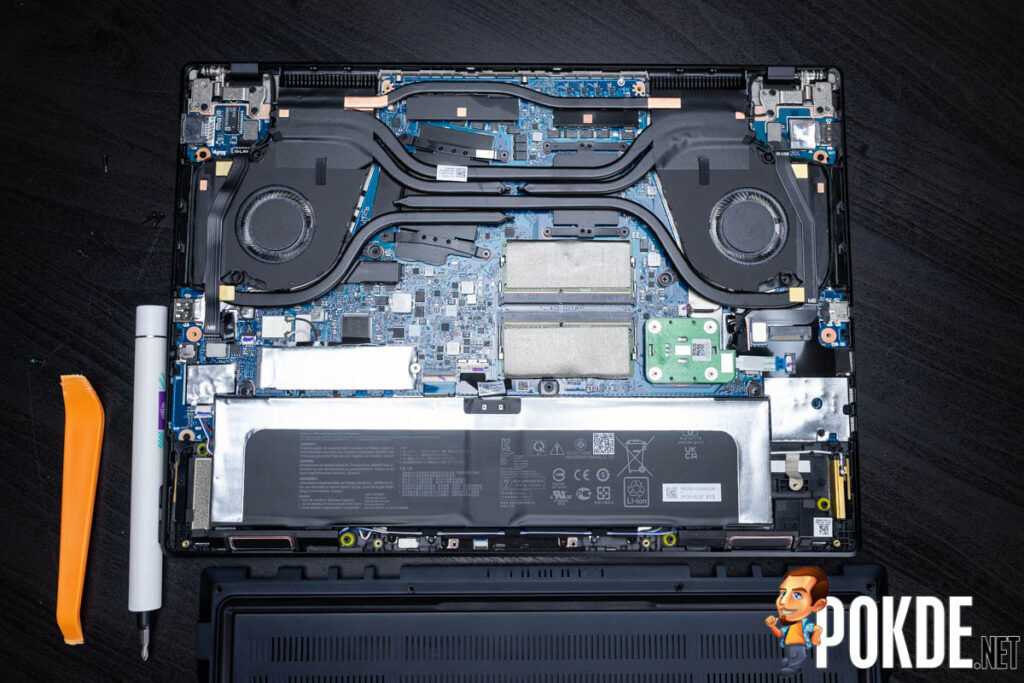
The six heat-pipe system and the heatspreaders that span out from them covers the VRM and VRAM, providing cooling to components that are often ignored. Unfortunately ASUS didn’t decide to use liquid metal here, so we could probably have seen better performance out of the ASUS ProArt Studiobook 16 OLED if ASUS decided to go with liquid metal and a more aggressive power profile on the chips.
ASUS ProArt Studiobook 16 OLED Specifications
| CPU | AMD Ryzen 9 5900HX, 8C/16T @ 3.3GHz (Boost up to 4.6GHz), 45W+ TDP, 7nm |
| RAM | 64GB DDR4-3200 (2 x 32GB SO-DIMM), dual-channel |
| Graphics | AMD Radeon Graphics, 8CU @ up to 2.1GHzNVIDIA GeForce RTX 3070 Laptop GPU 8GB GDRR6, 90W TGP (110W with Dynamic Boost |
| Storage | 1TB WD PC SN730 M.2 PCIe 3.0 x4 SSD 1 x M.2 2280 PCIe slot vacant |
| Connectivity |
WirelessIntel Wireless-AC 9260 (WiFi 5 + Bluetooth 5.1)Wired 2 x USB 3.2 Gen 2 (Type-C), 10Gbps 2 x USB 3.2 Gen 2 (Type-A), 10Gbps 1 x SD Express 7.0 card reader 1 x Realtek RTL8111 GbE LAN 1 x 3.5mm audio jack |
| Display | 16″ WQUXGA (3840 x 2400) 16:10 OLED display (Samsung SDC415D) 550 nits, 100% DCI-P3, Pantone Validated, VESA DisplayHDR True Black 500 1 x HDMI 2.1 2 x DisplayPort Alt Mode via USB-C |
| Audio | Stereo speakers, tuned by harman/kardon SonicMaster, Smart Amp technology Array microphone, Alexa, Cortana voice-recognition support AI Noise-Cancelling Mic + AI Noise-Cancelling Speaker |
| Power | 90WHrs 4-cell Li-ion battery 240W power adapter USB-PD charging support (not included) |
| Dimensions | 362 x 264 x 21.4 mm |
| Weight | 2.4kg |
Asus ProArt StudioBook 16 OLED review: Display and speakers
The ProArt StudioBook has an incredible display, a 16-inch 16:10 4K (3,840 x 2400 pixel) OLED panel with a peak brightness of 550 nits. Professional users will probably like the display, because you can colour grade HDR videos and photos accurately. It supports 100% of the DCI-P3 colour gamut, and boasts VESA Certified DisplayHDR True Black 500 for high contrast and is Pantone Validated for colour reproduction.
Although these numbers don’t matter to average users, for professionals a high-quality display matters. The resolution combined with punchy colours, deep blacks, bright whites and excellent contrast ratio gives you the picture quality comparable to that of a high-end 4K TV but in 16-inch screen size. For regular people like me, that means colours pop when watching movies and TV shows. This kind of display on a laptop makes a huge difference if you know the advantages of a 4K HDR OLED screen. A high-refresh-rate display could have been an advantage but that’s ok.
Advertisement
 The resolution combined with punchy colours, deep blacks, bright whites and excellent contrast ratio gives you the picture quality comparable to that of a high-end 4K TV but in 16-inch screen size. (Image credit: Anuj Bhatia/Indian Express)
The resolution combined with punchy colours, deep blacks, bright whites and excellent contrast ratio gives you the picture quality comparable to that of a high-end 4K TV but in 16-inch screen size. (Image credit: Anuj Bhatia/Indian Express)
Audio is a high point on the ProArt StudioBook 16 OLED. The Harman/Kardon-tuned speakers are way better than any other Windows laptop I’ve tested this year. They get plenty of loud and rich bass so you don’t need a Bluetooth speaker when listening to music and watching movies at home or on the go.
Benchmarks
PassMark result
48083
This benchmark measures the performance of the CPU using multiple threads.
PassMark result (single)
4341
This benchmark measures the performance of the CPU using a single thread.
Cinebench R20 (multi) result
Unknown. Help us by suggesting a value.
Cinebench R20 is a benchmark tool that measures a CPU’s multi-core performance by rendering a 3D scene.
Cinebench R20 (single) result
Unknown. Help us by suggesting a value.
Cinebench R20 is a benchmark tool that measures a CPU’s single-core performance by rendering a 3D scene.
Geekbench 6 result (multi)
Unknown. Help us by suggesting a value.
Geekbench 6 is a cross-platform benchmark that measures a processor’s multi-core performance. (Source: Primate Labs, 2024)
Geekbench 6 result (single)
Unknown. Help us by suggesting a value.
Geekbench 6 is a cross-platform benchmark that measures a processor’s single-core performance. (Source: Primate Labs, 2024)
Geekbench 5 result (multi)
Unknown. Help us by suggesting a value.
Geekbench 5 is a cross-platform benchmark that measures a processor’s multi-core performance. (Source: Primate Labs, 2024)
Geekbench 5 result (single)
Unknown. Help us by suggesting a value.
Geekbench 5 is a cross-platform benchmark that measures a processor’s single-core performance. (Source: Primate Labs, 2024)
Blender (bmw27) result
Unknown. Help us by suggesting a value.
The Blender (bmw27) benchmark measures the performance of a processor by rendering a 3D scene. More powerful processors can render the scene in less time.
Asus ProArt Studiobook 16 OLED (H5600)
Характеристики:
- Процессор: AMD Ryzen 9 5900HX
- Оперативная память: 32 ГБ
- Жёсткий диск: SSD, 2 ТБ
- Разрешение экрана: 3840 x 2400
- Частота обновления: 60 Гц
- Видеокарта: Nvidia GeForce RTX 3070
- Объём видеопамяти: 8 ГБ
Плюсы:
- Большой 16-дюймовый 4К-дисплей
- Отличная производительность в 3D
- Высокая производительность
- Металлический корпус премиум-класса
- Физический манипулятор Asus Dial
Может не понравиться:
- Частота обновления 60 Гц
- Высокая цена
- Низкая автономность работы
- Непривычное расположение клавиш
Ещё один ноутбук, который с первого взгляда притягивает профессионалов – это Asus ProArt Studiobook 16. Ноутбук имеет большой 16-дюймовый OLED-экран с разрешением 4K, высокопроизводительный процессор AMD Ryzen 9 и графику Nvidia GeForce RTX 30 Series, а также уникальную раскладку клавиатуры для работы с горячими клавишами и редакторами. Рядом с тачпадом можно также обнаружить физический регулятор Asus Dial, который однозначно оценят цифровые художники или видеомонтажёры. По производительности он не сильно отстаёт от того же Samsung Galaxy Book3 Ultra и может похвастаться большими объёмами памяти – 32 ГБ ОЗУ и 2 ТБ SSD-накопителем. Такой конфигурации будет более чем достаточно для всех требовательных приложений. Studiobook 16 – это мощный качественный ноутбук. Единственное к чему можно придраться, так это к батарее – её работы хватает максимум на 6 часов, что очень мало, чтобы использовать его вдали от работы или дома.
Ноутбук Asus ProArt Studiobook 16 OLED (H5600)
Compared To Other Laptops
Compared to other mobile workstations, the ASUS ProArt Studiobook 16 OLED is unique and stands out for its features, like its customizable dial, OLED display, and touchpad with pen input support.
For other options, see our recommendations for the best laptops, the best business laptops, and the best 2-in-1 laptops.
Apple MacBook Pro 16 (2021)
Searching
Finding Store
The ASUS ProArt Studiobook Pro 16 OLED (2021) and the Apple MacBook Pro 16 (2021) are both premium 16-inch mobile workstations designed for demanding production workloads like video editing and graphic design. Choosing between them depends on which applications you use and whether you can make use of each laptop’s unique features. For example, Final Cut Pro is only available on macOS, while Adobe applications tend to work better on Windows systems with an Intel CPU and an NVIDIA GPU. The ASUS has better overall graphical performance, especially if you get the RTX A5000 GPU; however, the Apple MacBook Pro has dedicated media engines that significantly improve performance in supported applications. If you want a laptop you can also game on, the ASUS is a better choice as games will run more smoothly on Windows.
Apple MacBook Pro 14 (2021)
Searching
Finding Store
The ASUS ProArt Studiobook Pro 16 OLED (2021) and the Apple MacBook Pro 14 (2021) are both premium mobile workstations that can handle demanding production workloads like video editing and CADs. The choice comes down to the size, your personal operating system preference, and the applications you use, as some apps will run better or are only available on a specific platform. The ASUS is more user-upgradeable and a better choice for gaming, as there’s a wider selection of games on Windows than on macOS with Apple silicon.
Dell Precision 3571 (2022)
Searching
Finding Store
The Dell Precision 3571 (2022) and the ASUS ProArt Studiobook Pro 16 OLED (2021) are very different. The ASUS is a significantly more expensive and premium device. It has better build quality, a better OLED display with wider Adobe RGB and DCI P3 coverage, a more comfortable keyboard, and a larger and more responsive touchpad. It also has more ports and doesn’t get as hot or loud under load. The Dell’s Intel 12th Gen CPUs perform better than the ASUS’ Intel 11th Gen, but the ASUS has more powerful GPU configurations.
Dell Precision 5560 (2021)
Searching
Finding Store
The ASUS ProArt Studiobook Pro 16 OLED (2021) and the Dell Precision 5560 (2021) are both premium Windows mobile workstations with Intel 11th Gen CPUs and NVIDIA discrete graphics. Choosing between them depends on whether you prefer as much performance as possible or a more compact and portable device. If you want performance, go with the ASUS because it has more powerful GPU options; otherwise, the Dell is a better option for portability. The ASUS’ OLED display has better picture quality, but keep in mind that there’s a risk of permanent burn-in, and it also flickers, which might cause eye strain for people sensitive to screen flickering.
Lenovo ThinkPad P1 Gen 4 (2021)
Searching
Finding Store
The ASUS ProArt Studiobook Pro 16 OLED (2021) and the Lenovo ThinkPad P1 Gen 4 (2021) are both high-end Windows mobile workstations with Intel 11th Gen CPUs and NVIDIA discrete GPUs. The Lenovo laptop has more CPU and GPU options, including the same ones available on the ASUS. However, the ASUS has a more robust cooling system, allowing the GPU to run at a higher wattage and provide better performance. The ASUS’ superior cooling system makes the device bulkier and heavier, so it isn’t as portable as the Lenovo. Aside from the extra features, like the ASUS Dial and the Lenovo Trackpoint, the other big difference is the display. The ASUS’ OLED panel looks better, but it’s prone to permanent burn-in, and its flickering might cause eye strain.
MSI WS76 (2021)
Searching
Finding Store
The MSI WS76 (2021) and the ASUS ProArt Studiobook Pro 16 OLED (2021) are both excellent Windows mobile workstations. The ASUS provides a better user experience overall with a more comfortable keyboard, a larger and more responsive touchpad, and a better webcam. It also feels sturdier, and its memory modules are easier to access if you want to upgrade them yourself. However, the MSI has much better performance over time, and its battery lasts longer.
Комментарий
NVIDIA NVIDIA GeForce RTX 4070 Laptop GPU:
Графические процессоры этой категории производительности составляют собой абсолютную элиту мира видеокарт. В том числе они справятся с любой игрой в максимальном качестве. Для оптимальной работы таких видеокарт обязательно большое количество энергии и мощная система охлаждения.
>> Больше сведений: Большой рейтинг видеокарт.
i9-13980HX: >> Больше сведений: Большой рейтинг процессоров.
16.00″: Ноутбуки с экраном диагональю 15…16 дюймов были наиболее популярными десять лет назад и остаются таковыми сейчас. Большинство моделей, выпускаемых каждый год, делаются именно в таком формате.>> Больше сведений: Рейтинг ноутбуков по качеству дисплея.
2.434 килог.: Вес больше среднего, адекватный для мощного ноутбука с крупным экраном.
87.28%: Хороший товар, но с довольно значимыми недостатками и/или не оправдывающий в полной мерю свою стоимость.
Вся информация — в наших подробных обзорах.
Внешний вид и комплектация
В комплект поставки входит ноутбук, документация и блок питания мощностью 240 Вт. Блок питания выполнен в «кирпичном» форм-факторе с парой кабелей по обе стороны и проприетарным штекером.
Зачастую ноутбуки с аналогичными характеристиками зовутся геймерскими решениями и стремятся удивить пёстрыми элементами дизайна. На наше счастье, ASUS ProArt Studiobook 16 OLED позиционируется, как устройство для создателей цифрового контента, и радует спокойным внешним видом без ярких деталей. Корпус выполнен из алюминия цвета Star Black. Отпечатки на крышке пусть и неохотно, но собираются.
На дне имеются вентиляционные отверстия, прорезиненные ножки, пара динамиков, выведенных в ближний к пользователю торец. Качество звука достойное, но в шумном офисе или на улице может не хватать громкости.
На торцах устройства расположились следующие разъёмы:
- 2 x USB-A 3.2 Gen2: до 10 Гбит/сек;
- 2 x USB-С 3.2 Gen2: до 10 Гбит/сек, DisplayPort (до 7680 × 4320), Power Delivery (20 В / 5 А), выходная мощность 5 В / 3 А;
- 1 x HDMI 2;
- 1 x комбинированный миниджек 3,5 мм;
- 1 x SD ридер 7.0 Express;
- 1 × порт для замка Kensington Lock;
- 1 × Ethtrnet-порт RJ45.
При необходимости можно и подключить дополнительные мониторы, и зарядить стороннее устройство аж на 15 Вт, а если родной блок питания не окажется под рукой, то и запитать сам ноутбук по USB-C на 100 Вт (20 В / 5 А)!
Ноутбук раскрывается на ~150°, что удобно при работе «вне стола». Однако стоит иметь в виду, что при немалых габаритах, весе 2,4 кг и умеренно высокой температуре корпуса рассчитывать на особо комфортный опыт работы на диване не стоит. Для таких сценариев лучше приглядеться к более лёгким и холодным устройствам. С другой стороны, на фоне большинства аналогов (в плане технических характеристик) ProArt Studiobook 16 OLED кажется относительно эргономичным.
Asus ProArt Studiobook 16 OLED (H7604) 2023 review: Display
In terms of color accuracy and coverage, Asus throws everything it can at the screens in its ProArt range. Here, that includes Calman Verified and Pantone Validated certifications, with the guarantee that each panel’s average Delta E (a measure of color accuracy) will be under two. Our panel’s accuracy was even better: it averaged 0.51 and had a maximum Delta E of 1.12.
Color coverage is superb, too. You have a choice of color profiles, including DCI-P3, where it covered 99% of the gamut. Print designers who prefer to work in the Adobe RGB space should stick to the Native profile, with 98% coverage.
But what really matters about this OLED panel is that it’s gorgeous. You benefit from incredible sharpness thanks to a resolution of 3,200 x 2,000, and whether you’re watching a film or editing photos you’ll fall in love with the rich colours and deep blacks. While a peak brightness of 363cd/m2 may not sound noteworthy, support for DisplayHDR’s True Black 500 shows that it can go higher in localized areas in supported content.
Its results in our 1080p gaming benchmark suite were predictably high: 186fps in F1 22, 144fps in Shadow of the Tomb Raider, 101fps in Metro Exodus, and 88fps in Metro Exodus Enhanced Edition. Those are all at High settings. Switching to the native resolution of 3,200 x 2,000 saw those figures drop to 105fps, 94fps, 56fps, and 45fps.
All our results were with the Studio drivers and the laptop in «MSHybrid» mode, where it automatically switches between discrete and integrated graphics. You can choose to use only the discrete GPU, but that made no difference to our results so we suggest sticking with the default.
Not least because using integrated graphics will squeeze some extra life from the 90W battery. The Studiobook is a power-hungry beast, and the best result we saw was in PCMark’s idle test where it kept going for 6hrs 36mins. It lasted around five hours in both the video-rundown and light-use office tests while switching to gaming reduced life to a mere 1hr 34mins. Those results are typical of a Windows workstation such as this, but the 16in MacBook Pro lasted for almost 20 hours in our video-rundown test.
Тесты в бенчмарках
Passmark
В бенчмарке Passmark проводится расширенная проверка процессора с поддержкой многопоточности. Выполняются сложные математические вычисления, включая физическое моделирование, сжатие и шифрование.
Core i9 13980HX
48601
из 98390
Процессор набрал 48601 из 98390 возможных баллов в данном бенчмарке. Максимальное количество имеет процессор, который находится на первом месте в рейтинге.
Производительность в играх
Core i9 13980HX подходит под 100 % минимальных и 100 % рекомендуемых системных требований игр, которые есть у нас на сайте. Для отдачи всей мощности процессора должна быть соответствующая видеокарта.
Минимальные требования
100 %
Рекомендуемые требования
100 %
Характеристики
Характеристики процессора — это официальные данные о мощности процессора, его возможностях и поддержке различных технологий. Но в большей степени нужно учитывать реальные тесты в программах и играх.
Основные характеристики
| Сокет подключения | FCBGA1964 |
| Сокет подключения — важная составляющая. По нему подбирается материнская плата. | |
| Количество ядер | 24 |
| Количество потоков | 32 |
| Максимальная тактовая частота | 5.5 GHz |
| Максимальная частота процессора достигается посредством нагрузки на процессор и по мере необходимости. Также можно разогнать процессор, выставив для этого соответствующий множитель. | |
| Базовая тактовая частота | 2.2 GHz |
| Максимальная температура | 100 °C |
| Встроенная графическая карта | Intel UHD Graphics for 13th Gen Intel Processors |
| Позволяет компьютеру работать без полноценной дискретной видеокарты и без графического чипа на материнской плате. | |
| Энергопотребление | 55 W |
| При разгоне процессора, он может требовать порой в 2 раза больше заявленного энергопотребления. Стоит выбирать блок питания с запасом. |
Дополнительно
| PCI Express | 5.0 and 4.0 |
| Технологический процесс | Intel 7 nm |
| Совместимость с Windows 11 | + |
| Кэш 1-го уровня | 80 KB (per core) |
| Кэш 2-го уровня | 2 MB (per core) |
| Кэш 3-го уровня | 36 MB |
| Разблокированный множитель | — |
Intel Core i9-12900HX
34.5
Intel Core i5-12450H
18.9
Intel Core i5-1240P
17.8
ASUS ProArt Studiobook 16 (H5600): Display
Source: Rich Edmonds / Windows Central (Image credit: Source: Rich Edmonds / Windows Central)
The display is incredibly important if you work with creative suites like Adobe. Thankfully, ASUS went all out with the ProArt Studiobook 16 (H5600). The review sample we received has the upgraded 4K (3840×2400) 16:10 panel with a brightness output of about 500 nits. The refresh rate caps out at 60Hz, but there is G-Sync support for gaming.
Color reproduction is simply stunning. It’s an IPS OLED display, meaning you get crystal colors with deep blacks. ASUS actually calibrates the panel to meet Pantone Validated standards with Calman Verified certification, and we found it to match what’s marketed without any tweaking. This panel would give even Dell a run for its money.
Running a screen profile and calibration test show just how capable this display is for creative work. Without tweaking anything on the screen, we managed to achieve 100% sRGB, 99.3% Adobe RGB, and 100% DCI P3. While it’s the most expensive configuration for the ASUS ProArt Studiobook 16, I’d recommend going for the 4K panel if your budget can stretch.














![Core i9 13980hx vs core i9 13900h [benchmarks 2024] - tech4gamers](http://peresvet-team.ru/wp-content/uploads/2/2/8/228c1a6ce3126993e285103392e2c816.jpeg)









![Core i9 13980hx vs core i9 13900h [benchmarks 2024]](http://peresvet-team.ru/wp-content/uploads/d/9/4/d94c42b9f876b604e1d991068e05edb0.jpeg)



